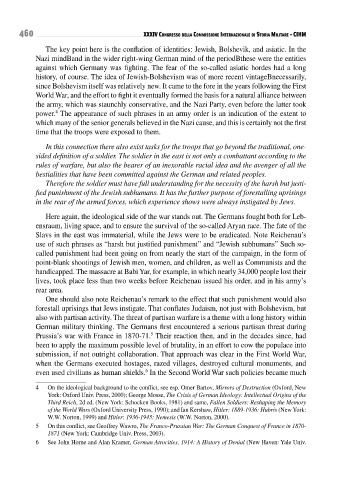Page 460 - Conflitti Militari e Popolazioni Civili - Tomo I
P. 460
460 XXXIV Congresso della CommIssIone InternazIonale dI storIa mIlItare • CIHm
The key point here is the conflation of identities: Jewish, Bolshevik, and asiatic. In the
Nazi mindBand in the wider right-wing German mind of the periodBthese were the entities
against which Germany was fighting. The fear of the so-called asiatic hordes had a long
history, of course. The idea of Jewish-Bolshevism was of more recent vintageBnecessarily,
since Bolshevism itself was relatively new. It came to the fore in the years following the First
World War, and the effort to fight it eventually formed the basis for a natural alliance between
the army, which was staunchly conservative, and the Nazi Party, even before the latter took
4
power. The appearance of such phrases in an army order is an indication of the extent to
which many of the senior generals believed in the Nazi cause, and this is certainly not the first
time that the troops were exposed to them.
In this connection there also exist tasks for the troops that go beyond the traditional, one-
sided definition of a soldier. The soldier in the east is not only a combattant according to the
rules of warfare, but also the bearer of an inexorable racial idea and the avenger of all the
bestialities that have been committed against the German and related peoples.
Therefore the soldier must have full understanding for the necessity of the harsh but justi-
fied punishment of the Jewish subhumans. It has the further purpose of forestalling uprisings
in the rear of the armed forces, which experience shows were always instigated by Jews.
Here again, the ideological side of the war stands out. The Germans fought both for Leb-
ensraum, living space, and to ensure the survival of the so-called Aryan race. The fate of the
Slavs in the east was immaterial, while the Jews were to be eradicated. Note Reichenau’s
use of such phrases as “harsh but justified punishment” and “Jewish subhumans” Such so-
called punishment had been going on from nearly the start of the campaign, in the form of
point-blank shootings of Jewish men, women, and children, as well as Communists and the
handicapped. The massacre at Babi Yar, for example, in which nearly 34,000 people lost their
lives, took place less than two weeks before Reichenau issued his order, and in his army’s
rear area.
One should also note Reichenau’s remark to the effect that such punishment would also
forestall uprisings that Jews instigate. That conflates Judaism, not just with Bolshevism, but
also with partisan activity. The threat of partisan warfare is a theme with a long history within
German military thinking. The Germans first encountered a serious partisan threat during
Prussia’s war with France in 1870-71. their reaction then, and in the decades since, had
5
been to apply the maximum possible level of brutality, in an effort to cow the populace into
submission, if not outright collaboration. That approach was clear in the First World War,
when the Germans executed hostages, razed villages, destroyed cultural monuments, and
even used civilians as human shields. in the Second World War such policies became much
6
4 On the ideological background to the conflict, see esp. Omer Bartov, Mirrors of Destruction (Oxford, New
York: Oxford Univ. Press, 2000); George Mosse, The Crisis of German Ideology: Intellectual Origins of the
Third Reich, 2d ed. (New York: Schocken Books, 1981) and same, Fallen Soldiers: Reshaping the Memory
of the World Wars (Oxford University Press, 1990); and Ian Kershaw, Hitler: 1889-1936: Hubris (New York:
W.W. Norton, 1999) and Hitler: 1936-1945: Nemesis (W.W. Norton, 2000).
5 On this conflict, see Geoffrey Wawro, The Franco-Prussian War: The German Conquest of France in 1870-
1871 (New York: Cambridge Univ. Press, 2003).
6 See John Horne and Alan Kramer, German Atrocities, 1914: A History of Denial (New Haven: Yale Univ.

